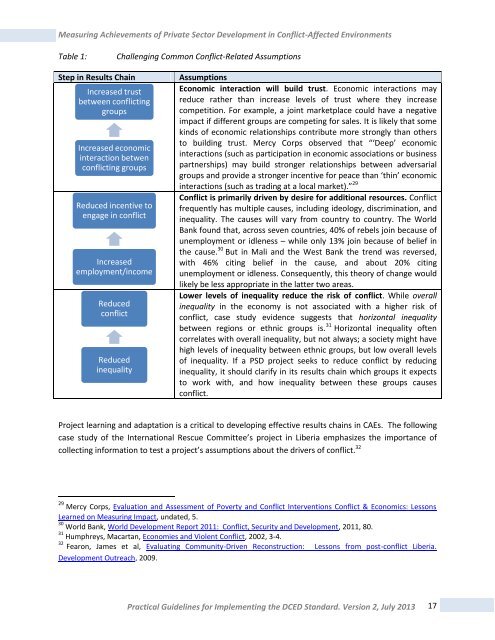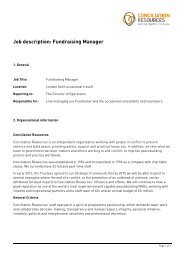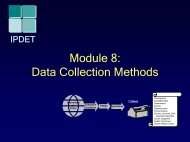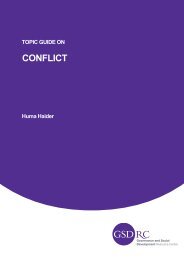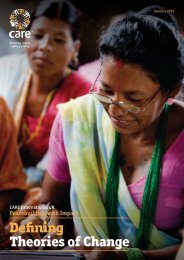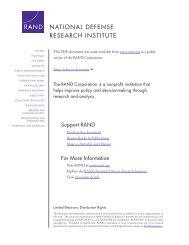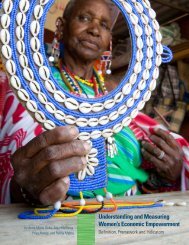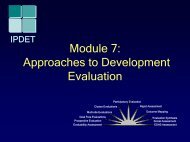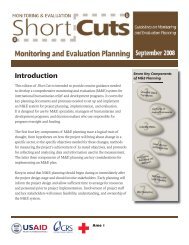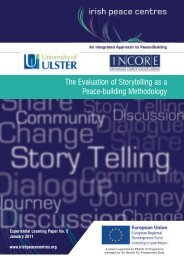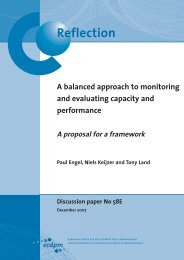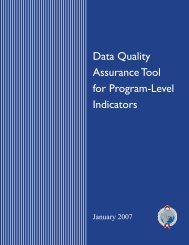Measuring Achievements of Private Sector Development in ... - DCED
Measuring Achievements of Private Sector Development in ... - DCED
Measuring Achievements of Private Sector Development in ... - DCED
Create successful ePaper yourself
Turn your PDF publications into a flip-book with our unique Google optimized e-Paper software.
<strong>Measur<strong>in</strong>g</strong> <strong>Achievements</strong> <strong>of</strong> <strong>Private</strong> <strong>Sector</strong> <strong>Development</strong> <strong>in</strong> Conflict-Affected Environments<br />
Table 1:<br />
Challeng<strong>in</strong>g Common Conflict-Related Assumptions<br />
Step <strong>in</strong> Results Cha<strong>in</strong><br />
Increased trust<br />
between conflict<strong>in</strong>g<br />
groups<br />
Increased economic<br />
<strong>in</strong>teraction betwen<br />
conflict<strong>in</strong>g groups<br />
Reduced <strong>in</strong>centive to<br />
engage <strong>in</strong> conflict<br />
Increased<br />
employment/<strong>in</strong>come<br />
Reduced<br />
conflict<br />
Reduced<br />
<strong>in</strong>equality<br />
Assumptions<br />
Economic <strong>in</strong>teraction will build trust. Economic <strong>in</strong>teractions may<br />
reduce rather than <strong>in</strong>crease levels <strong>of</strong> trust where they <strong>in</strong>crease<br />
competition. For example, a jo<strong>in</strong>t marketplace could have a negative<br />
impact if different groups are compet<strong>in</strong>g for sales. It is likely that some<br />
k<strong>in</strong>ds <strong>of</strong> economic relationships contribute more strongly than others<br />
to build<strong>in</strong>g trust. Mercy Corps observed that “‘Deep’ economic<br />
<strong>in</strong>teractions (such as participation <strong>in</strong> economic associations or bus<strong>in</strong>ess<br />
partnerships) may build stronger relationships between adversarial<br />
groups and provide a stronger <strong>in</strong>centive for peace than ‘th<strong>in</strong>’ economic<br />
<strong>in</strong>teractions (such as trad<strong>in</strong>g at a local market).” 29<br />
Conflict is primarily driven by desire for additional resources. Conflict<br />
frequently has multiple causes, <strong>in</strong>clud<strong>in</strong>g ideology, discrim<strong>in</strong>ation, and<br />
<strong>in</strong>equality. The causes will vary from country to country. The World<br />
Bank found that, across seven countries, 40% <strong>of</strong> rebels jo<strong>in</strong> because <strong>of</strong><br />
unemployment or idleness – while only 13% jo<strong>in</strong> because <strong>of</strong> belief <strong>in</strong><br />
the cause. 30 But <strong>in</strong> Mali and the West Bank the trend was reversed,<br />
with 46% cit<strong>in</strong>g belief <strong>in</strong> the cause, and about 20% cit<strong>in</strong>g<br />
unemployment or idleness. Consequently, this theory <strong>of</strong> change would<br />
likely be less appropriate <strong>in</strong> the latter two areas.<br />
Lower levels <strong>of</strong> <strong>in</strong>equality reduce the risk <strong>of</strong> conflict. While overall<br />
<strong>in</strong>equality <strong>in</strong> the economy is not associated with a higher risk <strong>of</strong><br />
conflict, case study evidence suggests that horizontal <strong>in</strong>equality<br />
between regions or ethnic groups is. 31 Horizontal <strong>in</strong>equality <strong>of</strong>ten<br />
correlates with overall <strong>in</strong>equality, but not always; a society might have<br />
high levels <strong>of</strong> <strong>in</strong>equality between ethnic groups, but low overall levels<br />
<strong>of</strong> <strong>in</strong>equality. If a PSD project seeks to reduce conflict by reduc<strong>in</strong>g<br />
<strong>in</strong>equality, it should clarify <strong>in</strong> its results cha<strong>in</strong> which groups it expects<br />
to work with, and how <strong>in</strong>equality between these groups causes<br />
conflict.<br />
Project learn<strong>in</strong>g and adaptation is a critical to develop<strong>in</strong>g effective results cha<strong>in</strong>s <strong>in</strong> CAEs. The follow<strong>in</strong>g<br />
case study <strong>of</strong> the International Rescue Committee’s project <strong>in</strong> Liberia emphasizes the importance <strong>of</strong><br />
collect<strong>in</strong>g <strong>in</strong>formation to test a project’s assumptions about the drivers <strong>of</strong> conflict. 32<br />
29 Mercy Corps, Evaluation and Assessment <strong>of</strong> Poverty and Conflict Interventions Conflict & Economics: Lessons<br />
Learned on <strong>Measur<strong>in</strong>g</strong> Impact, undated, 5.<br />
30 World Bank, World <strong>Development</strong> Report 2011: Conflict, Security and <strong>Development</strong>, 2011, 80.<br />
31 Humphreys, Macartan, Economies and Violent Conflict, 2002, 3-4.<br />
32 Fearon, James et al, Evaluat<strong>in</strong>g Community-Driven Reconstruction: Lessons from post-conflict Liberia.<br />
<strong>Development</strong> Outreach, 2009.<br />
Practical Guidel<strong>in</strong>es for Implement<strong>in</strong>g the <strong>DCED</strong> Standard. Version 2, July 2013<br />
17


